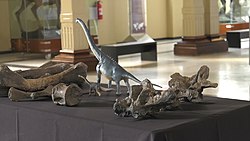| Hornitos Formation | |
|---|---|
| Stratigraphic range: Late Cretaceous, Campanian–Maastrichtian PreꞒ Ꞓ O S D C P T J K Pg N | |
| Type | Geological formation |
| Lithology | |
| Primary | Limestone, sandstone, conglomerate |
| Other | Marl, tuff |
| Location | |
| Coordinates | 28°00′S 70°18′W / 28.0°S 70.3°W / -28.0; -70.3 |
| Approximate paleocoordinates | 30°36′S 54°30′W / 30.6°S 54.5°W / -30.6; -54.5 |
| Region | Atacama |
| Country | |
| Extent | Algarrobal Basin |
 | |
The Hornitos Formation is a Campanian geologic formation of the Algarrobal Basin in the Atacama Region of northern Chile. The formation comprises limestones, sandstones, conglomerates, marls and tuff. Dinosaur remains are among the fossils that have been recovered from the formation, including the sauropod Arackar licanantay.
Description
The Hornillos Formation, deposited in the Algarrobal Basin, comprises sandstones, limestones, conglomerates, and caliches, intercalated with lavas and andesitic breccias and various volcanic rocks. Between these last is a conspicuous layer of rhyo-dactitic lithic tuff, which reaches up to 10 metres (33 ft) in thickness. Bones of indeterminate titanosaurs appear in a marly limestone stratum of 10 metres (33 ft) thick with decimeter-sized calcareous concretions. The smallest pieces were found as rollings, whereas the larger piece was included in the limestone.
The Hornitos Formation formerly was thought to be of Paleocene to Eocene age. The formation may be older and belong to the Early Cretaceous, as a granite intruded the rocks about 105 ± 10 Ma.
Fossil content
Color key
|
Notes Uncertain or tentative taxa are in small text; |
Dinosaurs
Sauropods
| Sauropods of the Hornitos Formation | ||||||
|---|---|---|---|---|---|---|
| Genus | Species | Location | Stratigraphic position | Material | Notes | Images |
| Arackar | A. licanantay | Atacama Region | Campanian to Maatrishtian | Femur, Humerus and Ischium | A lithostrotian titanosaur; closely related to Isisaurus colberti. |  |
See also
References
- Weishampel, et al. (2004). "Dinosaur distribution." pp. 517–607.
- Abad, 1982, p. 5
- Hornitos at Fossilworks.org
- Rivera Cabello, 1985, p. 5
- Rivano et al., 1986, p. 28
- Rubilar-Rogers D, Vargas AO, Riga BG, Soto-Acuña S, Alarcón-Muñoz J, Iriarte-Díaz J, Arévalo C, Gutstein CS (2021). "Arackar licanantay gen. et sp. nov. a new lithostrotian (Dinosauria, Sauropoda) from the Upper Cretaceous of the Atacama Region, northern Chile". Cretaceous Research. 124: Article 104802. Bibcode:2021CrRes.12404802R. doi:10.1016/j.cretres.2021.104802. S2CID 233780252.
Bibliography
- Abad E., Eduardo (1982), Un modelo de depositación de uranio en la Cuenca de Algarrobal, Vallenar, Chile (PDF), III Congreso Geológico Chileno, pp. 1–37, archived from the original (PDF) on 2018-09-09, retrieved 2018-09-08
- Rivano G., Sergio (1986), "Antecedentes radiométricos para una edad cretácica inferior de la Formación Las Chilcas", Andean Geology, 27: 27–32, retrieved 2018-09-08
- Rivera Cabello, Sergio (1985), Una discusión sobre la edad de las formaciones Cerrilos y Hornitos, Región de Atacama (PDF), IV Congreso Geológico Chileno, pp. 1–13, archived from the original (PDF) on 2018-09-09, retrieved 2018-09-08
- Weishampel, David B.; Dodson, Peter; Osmólska, Halszka (2004), The Dinosauria, 2nd edition, Berkeley: University of California Press, pp. 1–880, ISBN 0-520-24209-2, retrieved 2019-02-21
Further reading
- G. Chong Diaz. 1985. Hallazgo de restos oseos de dinosaurios en la Formación Hornitos – Tercera Region de Atacama – Chile. IV Congreso Geologico Chileno 152–161
- P. Salinas, P. Sepúlveda, and L. G. Marshall. 1991. Hallazgo de restos oseos de dinosaurios (saurópodos) en la Formación Pajonales (Cretácico Superior), Sierra de Almeyda, Región de Antofagasta, Chile: implicancia cronológica . 6e Congreso Geológico Chileño, Viña del Mar. Resumenes Expandidos. Servicio Nacional de Geología y Mineria, Chile 534-537